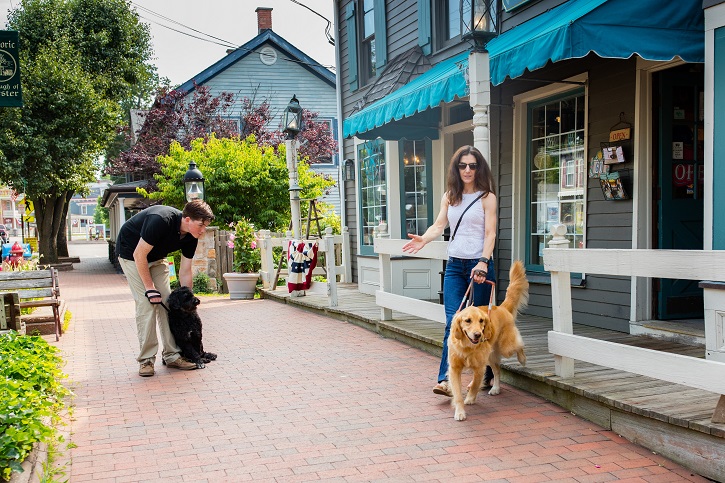For Immediate Release
Contact: Michelle Barlak, (973) 539-4425
mbarlak@seeingeye.org
July 25, 2018
Seeing Eye PSA Asks Pet Owners to Help Keep Guide Dog Teams Safe
As Summer Heats up, Harassment of Guide Dogs Surges

MORRISTOWN, NJ -- According to a nationwide survey of guide dog handlers conducted by The Seeing Eye, nearly 85 percent of guide dog teams experienced serious interference from other dogs. As summer heats up and more people are out and about, the chance for guide dogs to be distracted, chased, harassed or bitten by pet dogs surges, according to the survey.
This is a problem that The Seeing Eye aims to tackle with the recent release of its public service campaign, “Guide Dog At Work.” The world’s oldest guide dog school asks fellow dog lovers to visit and then share GuideDogAtWork.org to help spread awareness of what to do when your dog meets a guide dog team.
“Many pet owners don’t realize that permitting their dogs to interact with a guide dog can put a blind person’s safety at risk,” said Jim Kutsch, President and CEO of The Seeing Eye. “It can be really difficult for my Seeing Eye® dog to focus on guiding me safely from one place to the next when other dogs are trying to visit with him. This distraction can cause him to make a mistake that could lead to injury for both of us.”
In the guide dog survey, 58 percent of handlers reported interference from dogs that were actually held on a leash by their owners, and almost one-third (27%) experienced interference from dogs that were tied up and left unsupervised. For the purpose of the survey, interference was defined as any dog who aggressively obstructs, intimidates, chases, harasses or otherwise jeopardizes the safety and emotional well-being of a guide dog team. The survey showed that even well-meaning encounters with pet dogs can lead to interference in an alarming number of cases, despite the best intentions of the pet owner.
“Even the friendliest of dogs can be a dangerous distraction to a guide dog team,” said Dave Johnson, Director of Instruction and Training at The Seeing Eye. “Guide dogs are trained to ignore interfering dogs but at the end of the day, they are still dogs and they can be affected by distractions. For a team to work safely and effectively, the guide dog must stay focused on its work at all times. In addition to the immediate danger from interfering dogs, over time, interference can compromise a dog’s training. This can be cause for retraining, or even rob blind handlers of the ability to travel freely in their own communities, disrupting their routines and curtailing their independence.”
Tips to help guide dog teams stay safe
1. Always keep your pet away from a guide dog, even if your dog is leashed. Staying a safe distance away helps the guide dog remain focused on its work.
2. Let the blind person know you are there. A quick greeting such as “Hello, I have a dog with me” is often appreciated.
3. Never let someone walk your pet who is unable to control it. Even a friendly dog can be difficult to manage at times.
4. Keep your dog under good control at all times. Using a retractable leash in populated areas and leaving your dog tied up outside unattended in a public place can endanger both the guide dog team and your own dog.
The Guide Dog at Work campaign features a brief educational video and tip sheets in both English and Spanish for pet owners at www.GuideDogAtWork.org. For more information on how you can help guide dog teams stay safe, email advocacy@seeingeye.org.
Established in 1929, The Seeing Eye provides specially bred and trained dogs to guide people who are blind. Seeing Eye dog users experience greatly enhanced mobility and independence, allowing them to retain their active lifestyles despite blindness. The Seeing Eye is a 501(c)3 non-profit supported by contributions from individuals, corporations and foundations, bequests, and other planned gifts.
The Seeing Eye is a trademarked name and can only be used to describe the dogs bred and trained at the school’s facilities in Morristown, N.J. If you would like more information on The Seeing Eye, please visit the website at www.SeeingEye.org, call (973) 539-4425, or email info@seeingeye.org.
###





